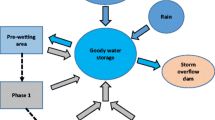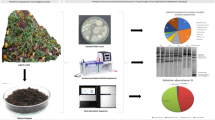Abstract
The aim of the study was to investigate microbial succession in the mushroom supply chain from compost, casing to fruit body formation and mushroom growth to the point of harvest, packing and point of sale. The microbial population dynamics of compost, casing and mushrooms were determined using a plate count technique, denaturing gradient gel electrophoresis (DGGE) and sequencing of 16S and 18S rDNA. Plating revealed greater abundance of bacteria, fungi and yeasts in mushroom compost compared to casing and fresh mushroom samples. The viable count method also showed that bacteria and yeasts increased significantly after harvest and during cold storage. Sequencing revealed a more diverse culturable bacterial population in casing and on the mushrooms than in the compost. Phylogenetic analysis revealed a general trend of grouping of species from the same sources. In contrast, a higher microbial diversity was recorded in compost when using the DGGE method, which reflects both cultural and non-culturable microorganisms. For compost and casing bacteria studied using DGGE, several species formed separate lineages, demonstrating highly diverse communities in these samples. Fungi were shown to be less abundant and less diverse compared to bacteria and yeasts. The study provides baseline knowledge of microbial populations and succession trends in mushroom production systems using viable and non-viable methods. The information provided in this study may be useful for microbial ecology studies and to identify and develop biocontrol systems for pathogen control during production or to enhance pinning stimulation by knowing when to apply Pseudomonas spp. to ensure increased yield. Finally, an insight is provided into microbial survival during cold storage and marketing of mushrooms. Potential antagonistic populations known to prevent spoilage, quality deterioration and extend shelf life are listed in this paper.






Similar content being viewed by others
References
Abad M, Noguera V, Martínez-Corts J (1989) The effect of sedge peat-based media and controlled-release fertilizer on the growth of begonia, French marigold and geranium. Acta Hortic 246:199–212
Amann RI, Ludwig W, Schleifer KH (1995) Phylogenetic identification and in situ detection of individual microbial cells without cultivation. Microbiol Rev 59:143–169
Burton KS, Noble R (1993) The influence of flush number, bruising and storage temperature on mushroom quality. Postharvest Biol Technol 3:39–47
Camp HJMO, Stumm CK, Straatsma G, Derikx PJL, van Griensven JLD (1990) Hyphal and mycelia interactions between A. bisporus and Scytalidium thermophilum on agar media. Microb Ecol 19:303–309
Chikthimmah N (2006) Microbial ecology of mushroom casing soils and preharvest strategies to enhance safety and quality of fresh mushrooms. PhD Thesis, Pennsylvania State University, USA
Choudhury PR, Heinemann JA (2006) The general secretory pathway of Burkholderia gladioli pv. agaricicola BG164R is necessary for cavity disease in white button mushrooms. Appl Environ Microbiol 72:3558–3565
Doores S, Kramer M, Beelman R (1987) Evaluation and bacterial populations associated with fresh mushrooms (Agaricus bisporus). In: Wuest PJ, Royce DL, Beelman RB (eds) Cultivating edible fungi. Developments in crop science, vol 10. Elsevier, Amsterdam, pp 283–294
Drancourt M, Bollet C, Carlioz A, Martelin R, Gayral J-P, Raoult D (2000) 16S Ribosomal DNA sequence analysis of a large collection of environmental and clinical unidentifiable bacterial isolates. J Clin Microbiol 38:3623–3630
Eakin JH (1969) Let’s know more about peat. Mushroom News 17:12–15
Eicker A, van Greuning M (1989) Economical alternatives for topogenous peat as casing material in the cultivation of Agaricus bisporus in South Africa. S Afr J Plant Soil 6:129–135
Ellis RJ, Morgan P, Weightman AJ, Fry JC (2003) Cultivation dependent and -independent approaches for determining bacterial diversity in heavy-metal-contaminated soil. Appl Environ Microbiol 69:3223–3230
Everett KDE, Bush RM, Andersen AA (1999) Emended description of the order Chlamydiales, proposal of Parachlamydiaceae fam. nov. and Simkaniaceae fam. nov., each containing one monotypic genus, revised taxonomy of the family Chlamydiaceae, including a new genus and five new species, and standards for the identification of organisms. Int J Syst Bacteriol 49:415–440
Felske A, Wolterink A, van Lis R, de Vos WM, Akkermans AD (1999) Searching for predominant soil bacteria: 16S rDNA cloning versus strain cultivation. FEMS Microbiol Ecol 30:137–145
Fermor TR, Wood DA (1981) Degradation of bacteria by Agaricus bisporus and other fungi. J Gen Microbiol 126:377–387
Fermor T, Lincoln S, Noble R, Dobrovin-Pennington A, Colauto N (2000) Microbiological properties of casing. In: Van Griensven LJLD (ed) Science and cultivation of edible fungi. Balkema, Rotterdam, pp 447–454
Fett WF, Wells JM, Cescutti P, Wijey C (1995) Identification of exopolysaccharides produced by fluorescent pseudomonads associated with commercial mushroom (Agaricus bisporus) production. Appl Environ Microbiol 61:513–517
Fjellbirkeland A, Torsvik V, Øvereås L (2001) Methanotrophic diversity in an agricultural soil as evaluated by denaturing gradient gel electrophoresis profiles of pmoA, mxaF and 16S rDNA sequence. Antonie van Leeuwenhoek 79:209–217
Fordyce CJR (1970) Relative numbers of certain microbial groups present in compost used for mushroom (Agaricus bisporus) propagation. Appl Microbiol 20:196–199
Garbeva P, van Veen JA, van Elsas JD (2004) Microbial diversity in soil: selection of microbial populations by plant and soil type and implications for disease suppressiveness. Annu Rev Phytopathol 42:243–270
Hayes WA, Randle P, Last FT (1969) The nature of microbial stimulus affecting sporophore formation in Agaricus bisporus (Lange) Sing. Ann Appl Biol 64:177–187
IBM Corp (Released 2011) IBM SPSS statistics for Windows, version 20.0. IBM, Armonk, NY
Inglis PW, Burden JL, Peberdy JF (1996) Evidence for the association of the enteric bacterium Ewingella americana with internal stipe necrosis of Agaricus bisporus. Microbiology 142:3253–3260
Ivors KL, Collopy PD, Beyer DM, Kang S (2000) Identification of bacteria in mushroom compost using ribosomal RNA sequence. Compost Sci Util 8:247–253
Kaiser O, Puhler A, Selbitschka W (2001) Phylogenetic analysis of microbial diversity in the rhizoplane of oilseed rape (Brassica napus cv. Westar) employing cultivation-dependent and cultivation-independent approaches. Microb Ecol 42:136–149
Koorapati A, Foley D, Pilling R, Prakash A (2004) Electron-beam irradiation preserves the quality of white button mushrooms (Agricus bisporus) slices. J Food Sci 69:SNQ25–SNQ29
Labuschagne PM (1995) Casing media for Agaricus bisporus cultivation in South Africa. MSc Thesis, University of Pretoria, South Africa
Miller FC, Harper ER, Macauley BJ (1989) Field examination of temperature and oxygen relationships in mushroom composting stacks-consideration of stack oxygenation based on utilisation and supply. Aust J Exp Agric 29:741–750
Miller N, Gallespie JB, Doyle OPE (1995) The involvement of microbiological components of peat based casing materials. Mushroom Sci 14:313–321
Munsch P, Alatossava T (2002) Several pseudomonads, associated with the cultivated mushrooms Agaricus bisporus or Pleurotus sp., are hemolytic. Microbiol Res 157:311–315
Noble R, Dobrovin-Pennington A, Hobbs PH, Pederby J, Rodger A (2009) Volatile C8 compounds and pseudomonads influence primordium formation of Agaricus bisporus. Mycologia 101:583–591
Orgiazzi A, Bianciotto V, Bonfante P, Daghino S, Ghignone S, Lazzari A, Lumini E, Mello A, Napoli C, Perotto S, Vizzini A, Bagella S, Murat C, Girlanda M (2013) 454 Pyrosequencing analysis of fungal assemblages from geographically distant, disparate soils reveals spatial patterning and a core mycobiome. Diversity 5:73–98. doi:10.3390/d5010073
Øvereås L, Forney L, Daae FL, Torsvik V (1997) Distribution of bacterioplankton in meromictic lake Sælenvennet as determined by denaturing gradient gel electrophoresis of PCR amplified gene fragments coding for 16S RNA. Appl Environ Microbiol 63:3367–3373
Pearce DA, van der Gast CJ, Lawley B, Ellis-Evans JC (2003) Bacterioplankton community diversity in a maritime Antarctic lake, determined by culture-dependent and culture-independent techniques. FEMS Microbiol Ecol 45:59–70
Peters S, Koschinsky S, Schwieger F, Tebbe CC (2000) Succession of microbial communities during hot composting as detected by PCR-single-strand-conformation polymorphism-based genetic profiles of small-subunit rRNA genes. Appl Environ Microbiol 66:930–936
Ranjard L, Lehon PH, Mougel C, Schehrer L, Merdinoglu D, Chaussod R (2003) Sampling strategy in molecular microbial ecology: influence of soil sample size on DNA fingerprinting analysis of fungal and bacterial communities. Environ Microbiol 5(11):1111–1120
Reddy MS, Patrick ZA (1990) Effect of bacteria associated with mushroom compost and casing materials on basidiomata formation in Agaricus bisporus. Can J Plant Pathol 12:236–242
Riahi H, Eskash A, Shariatmadari Z (2011) Effect of bacterial and cyanobacterial culture on growth, quality and yield of Agaricus bisporus. Proceedings of the 7th International Conference on Mushroom Biology and Mushroom Products (ICMBMP7) 4–7 October 2011, Arcachon, France
Ross RC, Harris PJ (1983) An investigation into the selective nature of mushroom compost. Sci Hortic 19:55–64
Ryckeboer J, Mergaert J, Vaes K, Klammer S, de Clercq D, Coosemans J, Insam H, Swings J (2003a) A survey of bacteria and fungi occurring during composting and self-heating processes. Ann Microbiol 53:349–410
Ryckeboer J, Mergaert J, Coosemans J, Deprins K, Swings J (2003b) Microbiological aspects of biowaste during composting in a monitored compost bin. J Appl Microbiol 94:127–137
Sivanesan D (2003) Diversity among bacteria causing blotch disease on the commercial mushroom, Agaricus bisporus. MSc Thesis, Brock University, Ontario
Siyoum NA, Surridge K, Korsten L (2010) Bacterial profiling of casing materials for white button mushrooms (Agaricus bisporus) using denaturing gradient gel electrophoresis. S Afr J Sci 106(9/10), article #253, doi:10.4102/sajs. v106i9/10.253
Straatsma G, Samson RA, Olijnsma TW, Camp HJMOD, Gerrits JPG, van Griensven LJLD (1994) Ecology of thermophilic fungi in mushroom compost, with emphasis on Scytalidium thermophilum and growth stimulation of Agaricus bisporus mycelium. Appl Environ Microbiol 60:454–458
Székely AJ, Sipos R, Berta B, Vajna B, Hajdú C, Márialigeti K (2009) DGGE and T-RFLP analysis of bacterial succession during mushroom compost production and sequence-aided T-RFLP profile of mature compost. Microb Ecol 57:522–533
Venturini ME, Reyes JE, Rivera CS, Oria R, Blanco D (2011) Microbiological quality and safety of fresh cultivated and wild mushrooms commercialized in Spain. Food Microbiol 28:1492–1498
Verhoeven JTA (1986) Nutrient dynamics in minerotrophic peat mires. Aquat Bot 25:117–137
Wells JM, Sapers GM, Fett WF, Butterfield JE, Jones JB, Bouzar H, Miller FC (1996) Postharvest discoloration of the cultivated mushroom Agaricus bisporus caused by Pseudomonas tolaasii, P. ‘reactans’, and P. ‘gingeri’. Phytopathology 86:1098–1104
White TJ, Bruns T, Lee S, Taylor JW (1990) Amplification and direct sequencing of fungal ribosomal RNA genes for phylogenetics. In: Innis MA, Gelfand DH, Sninsky JJ, White TJ (eds) PCR protocols: a guide to methods and applications. Academic, New York, pp 315–322
Acknowledgments
This research was funded by the South African Mushroom Farmers Association (SAMFA), National Research Foundation (NRF) and the Technology and Human Resources for Industry Programme (THRIP) (a partnership programme funded by the Department of Trade and Industry and managed by the NRF). We would like to thank Dr. L. Meyer, Ms. R. Jacobs, for molecular advice and assistance, as well as Ms. A. Redmond for technical assistance. We also would like to thank the commercial farm for providing research materials.
Author information
Authors and Affiliations
Corresponding author
Electronic supplementary material
Below is the link to the electronic supplementary material.
Online Resource 1
(PDF 63 kb)
Online Resource 2
(PDF 135 kb)
Rights and permissions
About this article
Cite this article
Siyoum, N.A., Surridge, K., van der Linde, E.J. et al. Microbial succession in white button mushroom production systems from compost and casing to a marketable packed product. Ann Microbiol 66, 151–164 (2016). https://doi.org/10.1007/s13213-015-1091-4
Received:
Accepted:
Published:
Issue Date:
DOI: https://doi.org/10.1007/s13213-015-1091-4




